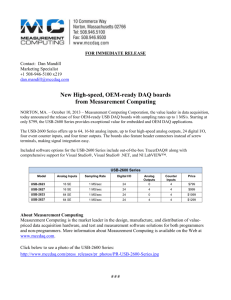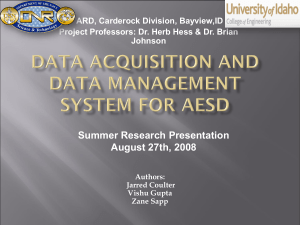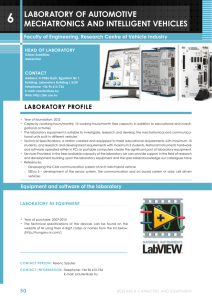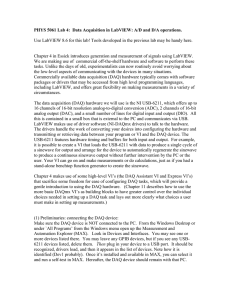The Future of Data Acquisition
advertisement
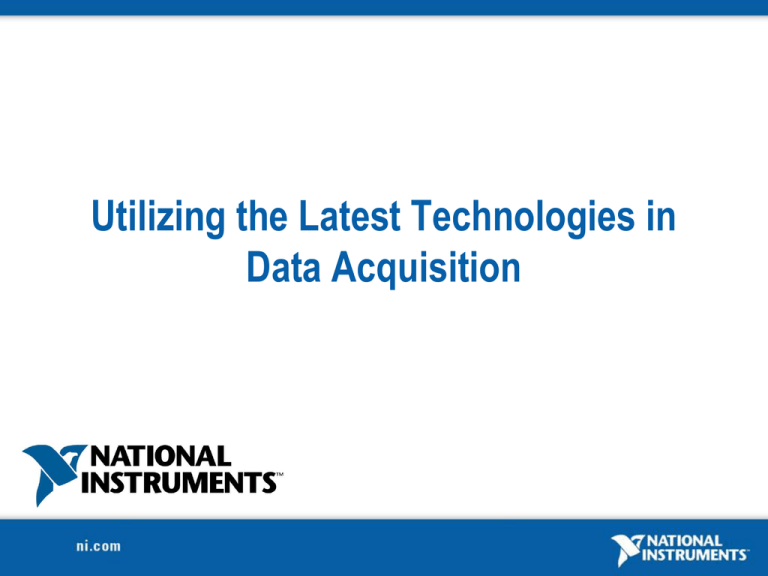
Utilizing the Latest Technologies in Data Acquisition Agenda • Computer Based DAQ Fundamentals • Utilizing New Technologies 2 PC-Based Data Acquisition (DAQ) Transducer Signal Signal Conditioning DAQ Software 3 PC-Based Data Acquisition (DAQ) Gas Turbine Engines NASA James Webb Space Telescope HIL Simulation for Hybrid Cars Bridge Health Monitoring in India Measuring Analog Input Signals Factors to consider: • Sampling rate • Resolution • Range and amplification • Noise and filtering 5 Analog I/O: Sampling Rates and Update Rates • Undersampling may result in the misrepresentation of the measured signal (aliasing). • After a signal is aliased, it is impossible to reconstruct the original signal. • Sample at least twice as fast as the highest frequency signal being measured. 6 Resolution • Number of bits analog-to-digital converter (ADC) uses to represent a signal • Higher resolution—Detect smaller voltage changes 16-Bit versus 3-Bit Resolution (5 kHz Sine Wave) 10.00 111 8.75 7.50 110 6.25 101 Amplitude 5.00 (Volts) 100 3-bit 011 3.75 010 2.50 001 1.25 0 16-bit | 0 000 | | 50 100 Time (ms) | | 150 7 200 16-Bit versus 12-Bit Measurements 8 Optimize Resolution with Amplification Amplifier Optimizes Resolution over the Range of the Measurement 16-bit Digitizer 10 mV signal 32 levels of resolution 16-bit Digitizer 10 V signal 65,536 levels of resolution 9 Use Lowpass Filters to Remove Noise Lowpass Filter Time Domain Time Domain Lowpass Filter Frequency Domain Frequency Domain • Removes noise • Blocks unwanted frequencies • Prevents aliasing 10 Improve Filtering Flexibility with Digital Filters Software (algorithmic) filters • Change filter topology • Change filter type (lowpass and so on) • Change cutoff frequency • Change filter order (number of poles) 11 Use a Combination of Analog and Digital Filters • Analog filters prevent signal aliasing • Circuit components dictate the type and frequency of the filter • Digital filters complement analog filters by providing infinite ―tunability‖ • Digital filters consume processor time but they can be used post-acquisition 12 Signal Conditioning Provides Amplification and Filtering Front-End Signal Conditioning SCC SCXI Integrated Signal Conditioning PXI Instruments SC Series FieldPoint cDAQ 13 Signal Conditioning Inputs • Low-level voltage signals (0–100 mV) • High voltage signals (10–1,000 V) • Sensors ― Thermocouples ― RTDs ― Strain Gauges ― Pressure Sensors ― Accelerometers ― Load Cells ― LVDTs/ RVDTs ― Resolvers 14 Hardware versus Software Timing 20 kHz Signal 1 kS/s to 20 kS/s varying by point 0 to 200 kS/s 50 ns timing accuracy Arbitrary sampling rates, point-by-point data Clocked sampling rate, buffered data 15 Using a Buffer to Acquire Samples • Use in conjunction with hardware timing • Continuous or finite length Data Board Memory Data PC Memory 16 Analog Triggering Acquired Signal Input Signal Trigger threshold Trigger Signal 17 Digital Triggering Acquired Signal Input Signal Trigger Signal 18 Analog Output Channel 0 DAC Channel 0 Channel 1 Channel 1 DAC • Most Multifunction DAQ devices have a digital-to-analog converter (DAC) for each of their analog output channels • DACs are updated simultaneously with the AO Sample Clock 19 Waveform Generation • Hardware time (clocked) buffered output • Each channel can output independently timed waveforms • Multiple AO operations can occur in parallel 20 Digital I/O • DIO with Multifunction DAQ Devices – Static (software-timed) DIO – Eight or 32 lines – Add SCXI or SCC for isolation • High Speed DIO – – – – Dedicated digital devices Up to 100 MHz clock rates Up to 64 Mbits/ch onboard memory Programmable voltage levels (–2.0 to 5.5 V) • Industrial DIO – Up to 60 V ranges – Built-in bank or channel-channel isolation 21 Utilizing the Latest Technologies in DAQ New Bus Technologies Digital Isolators and Their Impact on Measurement Performance Advanced Data Acquisition Techniques with Onboard FPGAs Timing and Synchronization Technologies for Challenging Applications 22 Utilizing the Latest Technologies in DAQ New Bus Technologies Digital Isolators and Their Impact on Measurement Performance Advanced Data Acquisition Techniques with Onboard FPGAs Timing and Synchronization Technologies for Challenging Applications 23 The Convenience of USB • Simplicity Plug and play • Wide Adoption 1 2.1 billion USB devices by 20091 4 USB ports per PC2 Electronics.ca Research Network, Feb 2005 Magazine.com, Dec 2005 2PC 24 USB Evolution 100000 1000 ISA PCI Express PCI 32/33 Gigabit Ethernet 100 Mbit Ethernet USB 2.0 100 10 USB 1.1 10 Mbit Ethernet Year 25 20 06 20 04 20 02 20 00 19 98 19 96 19 94 19 92 19 90 19 88 1 19 86 Speed (Mbits/S) 10000 USB Ethernet PC Buses Traditional USB DAQ Transfer Architecture 26 NI Signal Streaming Technology 27 Message Based Communication 28 Increased Device Intelligence • Device contains element of driver DAQmx 9215 9211 9263 9237 9233 9472 9481 29 NI Signal Streaming Performance Improvement 30 Wireless: The Next Bus for Data Acquisition USB Ethernet Wi-Fi CompactDAQ USB DAQ System USB-9xxx USB Carrier WLS-9xxx Wi-Fi Carrier Data Acquisition ENET-9xxx Ethernet Carrier Compact FieldPoint WAP WAP CompactRIO Wireless Programmable Automation Controllers (PACs) 31 NI Wi-Fi Data Acquisition • NI-DAQmx driver software • 10/100 Base-T/X Ethernet • IEEE 802.11b/g radio Easy to use Secure (IEEE 802.11i) High bandwidth Established infrastructure 32 Wi-Fi: The Basics Version Released Frequency Max Rate Range 802.11 1997 2.4 GHz 2 Mb/s ~30 m 802.11b 1999 2.4 GHz 11 Mb/s 30 m 802.11a 1999 5 GHz 54 Mb/s 10 m 802.11g 2003 2.4 GHz 54 Mb/s 30 m 802.11n 2009? 2.4 GHz ~540 Mb/s ~50 m • 2.4GHz is an unlicensed band You’re competing with cordless phones, Wi-Fi hotspots, and microwaves • 802.11b/g defines 11 channels to reduce interference 33 Wi-Fi Security • Three levels of Wi-Fi security WEP (not good) WPA (better) WPA2 (best, synonymous with IEEE 802.11i) • The best wireless security has two key components Encryption = data protection Authentication = access control 34 Encryption • TKIP = Temporal Key Integrity Protocol (WPA) • AES = Advanced Encryption Standard (WPA2) NIST-endorsed standard for government agencies FIPS-approved (FIPS 197) Key size (bits) Number of alternative keys Time required at 1 decryption/us Time required at 106 decryptions/us 32 232 = 4.3 x 109 35.8 minutes 2.15 milliseconds 56 256 = 7.2 x 1016 1,142 years 10 hours 128 2128 = 3.4 x 1038 5.4 x 1024 years 5.4 x 1018 years Time required for exhaustive key search (brute force attack) http://csrc.nist.gov/publications/fips/fips197/fips-197.pdf 35 Authentication • Three players in 802.11i authentication Supplicant = client trying to access network (Wi-Fi DAQ) Authenticator = WAP hardwired to secured network Authentication Server = verifies identity of client Supplicant Authenticator Authentication Sever 36 Native x1 PCI Express Interface • Dedicated bandwidth of up to 250 MB/s in each direction • 8 DMA channels • Software optimizations for low latency and single-point control applications 37 Utilizing the Latest Technologies in DAQ New Bus Technologies Digital Isolators and Their Impact on Measurement Performance Advanced Data Acquisition Techniques with Onboard FPGAs Timing and Synchronization Technologies for Challenging Applications 38 What is Isolation? • No direct electrical connection between two or more circuits • Floating from any other reference potential • Separated from undesired influence of another circuit • A.K.A. Not ―Touching‖ 39 Digital Isolation Analog Isolation Types of Isolation 40 Benefits of Isolation • Accuracy Eliminates ground loops Rejects common mode voltage • Safety Protection from voltage spikes Tested and certified • Simplicity 0 to 20 mA I/O, 24 V DIO No need for external conditioning 41 Accuracy: Eliminates Ground Loop • Common problem with single ended measurements • Cause - Difference in ground potentials • Differential – only good for under +/- 10 VDC Non-isolated DAQ Board Signal Ground voltage difference + - ~ AI AI Signal + - GND Ground Loop Isolated DAQ Board ≤ 60 V Ground voltage difference AI GND ~ Isolation GND No Ground Loop 42 Accuracy: Common Mode Voltage Rejection • Voltage common to both the + and - channels What will a non-isolated M Series board read? DAQ Board AI+ 5V + AI- 5V ?5 V GND Common Mode Voltage 43 Accuracy: Common Mode Voltage Rejection • Voltage common to both the + and - channels Isolated boards What will willareject non-isolated the common M Series mode board voltage readand now? read 5 V DAQ Board AI+ 5V + - ?5 V AI- ≤ 60 V 55 V Isolation Common Mode Voltage Automotive measurements • 42 V and 12 V common mode GND Battery stack testing • Small individual 1 V cells Signal + Common mode = ± 60 VDC Signal = ± 10 V (same as the non-isolated M Series) 44 Simplicity 1 Multifunction DAQ Board 3 2 External Isolation External 0-20 mA Analog I/O 5 4 SSRs To Handle 24V Logic Levels 45 Industrial Sensor / Actuator Simplicity 0-20 mA Analog I/O 2 3 1 Multifunction DAQ Board Isolation 4 SSRs To Handle 24V Logic Levels 5 46 Industrial Sensor / Actuator Safety from Hazardous Voltages • Protection for user, data and equipment from transients Isolated M and S Series: 1400 Vrms / 1950 VDC for up to 5 sec • Applications Factory floor, production lines, process control where high voltage and transient signals are common Proximity to large motors or wall power lines Medical equipment University Labs 47 Utilizing the Latest Technologies in DAQ New Bus Technologies Digital Isolators and Their Impact on Measurement Performance Advanced Data Acquisition Techniques with Onboard FPGAs Timing and Synchronization Technologies for Challenging Applications 48 Applications Requiring Custom Hardware • • • • • Custom data acquisition Digital communication protocols Decision making in hardware Control over 40 kHz Sensor level signal processing 49 Benefits of FPGAs Massively parallel Reconfigurable Digital signal processing High-speed control Faster time to market Typically require digital design expertise 50 Reconfigurable Intelligent DAQ • FPGA-based I/O timing • User-defined onboard processing • Hardware-timed speed and reliability 51 LabVIEW FPGA Module ` 52 Intellectual Property (IP) FFT DC/RMS Waveform Averaging Digital filtering Windowing Resampling 53 Typical MIO DAQ vs. Intelligent DAQ I/O Control Fixed ASIC for timing and triggering Open FPGA for timing and triggering Analog I/O Multiplexed, shared sample clock Simultaneous or independent operation Digital I/O Onboard Counters Up to 160 lines, hardware timed Up to 32 lines, Correlated DIO 2 general purpose counters Custom counters on any digital line 54 Custom Triggered Analog Input With Intelligent DAQ 55 Intelligent DAQ Applications • • • • • Custom timing/triggering Ultra-high speed control Sensor simulation Hardware-in-the-loop test Specialized communication protocols 56 Utilizing the Latest Technologies in DAQ New Bus Technologies Digital Isolators and Their Impact on Measurement Performance Advanced Data Acquisition Techniques with Onboard FPGAs Timing and Synchronization Technologies for Challenging Applications 57 Synchronizing Multiple Devices M Series 58 Multidevice Acquisition AND Logging Configure Logging.vi The easiest AND fastest way to log acquired data to disk 59 Importance of Timing in Test, Measurement and Control • Trending Allows interpolation Graph vs histogram DMM vs Digitizer • Correlation Relating two events to one another Phase • Controllability Timing of control loops Determinism • Simulation Capability Timing is inherent to a simulation 60 The Challenge Synchronize Dynamic Measurements Over Long Distances 61 RTSI and the PXI Trigger Bus RTSI RTSI 0 RTSI 1 RTSI 2 RTSI 3 RTSI 4 RTSI 5 RTSI 6 RTSI Clock PXI PXI_Trig0 PXI_Trig1 PXI_Trig2 PXI_Trig3 PXI_Trig4 PXI_Trig5 PXI_Star PXI_Trig7 • Direct mapping of RTSI signals to PXI Backplane Connector (J2), no ribbon cable needed 62 Considerations for Distance and Delay • Delay of a signal is proportional to the distance it has to travel • Star triggers are designed so all trigger signals have the same delay (<1 ns, <150ps) 63 Comparing Synchronization Technologies Precision 10-12 sec PXI Multichassis 10-9 sec GPS IRIG-B 10-6 sec Signal-based Time-based 10-3 sec sec <10-4m 10-2m 100m 101m 102m 103m 104m Proximity 64 105m Global Global Positioning System (GPS) • • • • Satellite constellation completed in March 1994 (1) Globally-available Time synchronization between 10’s and 100’s of ns Can be used to calculate position within meters (1) Source: Trimble http://www.trimble.com/gps/howgps-positions.shtml#0 65 IRIG • Inter-Range Instrumentation Group time codes • AM or DC method of encoding a time reference • Encoding/Decoding precision in the 10’s of ns 66 NTP • Network Time Protocol • Ethernet-based synchronization using standard NICs • Provides synchronization in the ms 67 IEEE 1588 – Precision Time Protocol Used to synchronize distributed time Operates via message-based two-way time exchange (like NTP) Automatically configures network in to master/slave hierarchy Protocol does not specify implementation Synchronization characteristics & applications are highly implementation specific 68 Time-Based Synchronization Solutions • IEEE1588 provides submicrosecond synchronization over Ethernet • Universal PCI connector for operation in 5 V and 3.3 V slots • Standard RJ-45 Ethernet plug and CAT 5 cabling • IEEE 1588-2002 compatibility • Auto-MDI capable for use with straight-through or crossover cables • Ideal for distributed measurement and remote industrial control applications PCI-1588 PXI-6682 69 Utilizing the Latest Technologies in DAQ New Bus Technologies Digital Isolators and Their Impact on Measurement Performance Advanced Data Acquisition Techniques with Onboard FPGAs Timing and Synchronization Technologies for Challenging Applications 70 71


